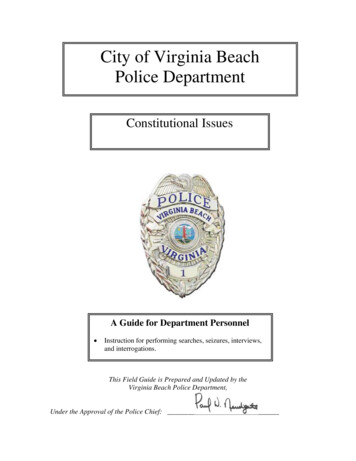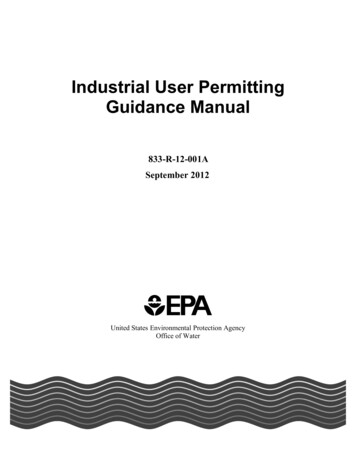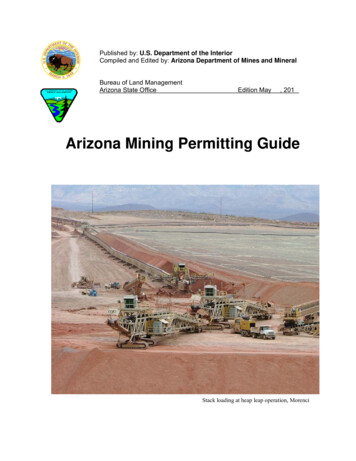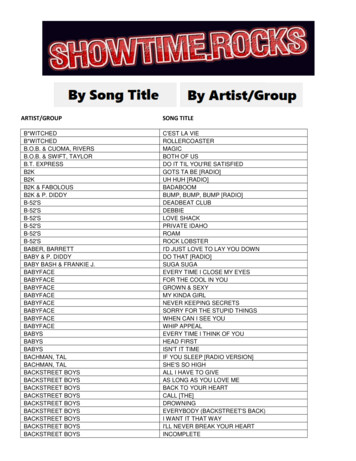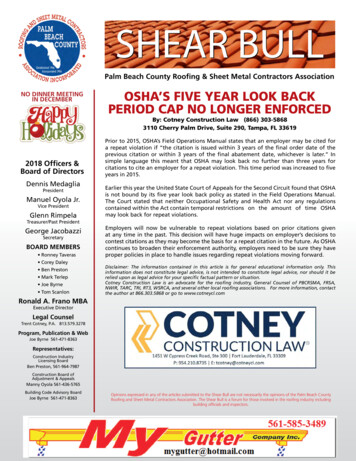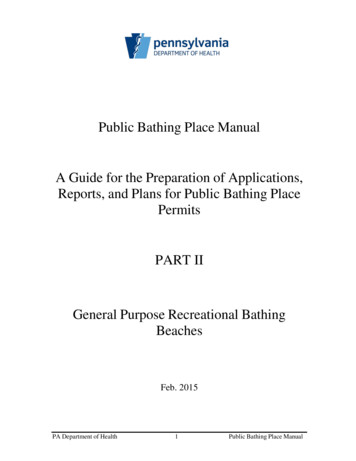
Transcription
Public Bathing Place ManualA Guide for the Preparation of Applications,Reports, and Plans for Public Bathing PlacePermitsPART IIGeneral Purpose Recreational BathingBeachesFeb. 2015PA Department of Health1Public Bathing Place Manual
PREFACESafe and healthful bathing places are great assets to our leisure time pursuits. ThePennsylvania Department of Health requires an Operating Permit for all publicswimming pools, spas, hot tubs and beaches. Chapter 18, the Public BathingCode, states “a permit shall be obtained from the Department prior toconstruction or operation of a public bathing place.”The chapter 18 construction requirement was amended by the passage of theUniform Construction Code (UCC). The UCC adopts by reference in 34Pennsylvania Code Section 403.26 the standard in ANSI/NSPI-1 2003 andANSI/NSPI-2 1999 for public swimming pools and spas respectively.Therefore, the Department of Health publication, the Public Bathing PlaceManual, Parts I and III are no longer used in approving construction permits forpublic swimming pools and spas. In many municipalities in Pennsylvania, thelocal code enforcement officer enforces the UCC. In the event that the localmunicipality has opted not to enforce the UCC, the Department of Labor andIndustry enforces the UCC for all new construction in those jurisdictions.Numerous sources of information were consulted during the writing of this manualbut Recommended Standards for Bathing Beaches by the Great Lakes—UpperMississippi River Board of State Sanitary Engineers was the primary reference usedto develop this manual.PA Department of Health2Public Bathing Place Manual
TABLE OF CONTENTSPAGE1.0 DEFINITIONS71.1 BATHING BEACH1.2 SHALL1.3 SHOULD7772.0 GENERAL INFORMATION82.1 THE BUREAU OF COMMUNITY HEALTH SYSTEMS2.1.1 Function2.1.2 Regulations2.1.3 District Offices2.2 SUBMISSION OF APPLICATION2.2.1 Procedures2.2.2 Engineers Report2.2.3 Specifications2.2.4 Plans2.2.5 Revisions to Approved Plans3.0 SANITARY SURVEY123.1 PURPOSE3.2 RESPONSIBILITY3.3 SCOPE3.3.1 Extent3.3.2 Potential Sources of Contamination3.3.2.1 Plot Map3.3.2.2 Nature and Sources of Contamination3.3.3 Bathing Beach Water Quality3.3.3.1 Set of Representative Samples3.3.3.2 Test Period3.3.3.3 Bacteriological Quality3.3.3.4 Physical Quality3.3.3.5 Biological Quality3.3.3.6 Chemical Quality3.3.4 Persons ContactedPA Department of Health8888-9101010-111111123Public Bathing Place Manual12121212121212-1313131313-1414141414-15
3.3.53.3.63.3.73.3.8Weather and Topographical InfluencesWater CurrentsFlow of WaterBoat Traffic151515154.0 BEACH SIZE AND USER LOAD164.1 DESIGNATION OF AREAS4.2 POSTING OF USER LOAD4.3 DESIGN LOADING4.3.1 Shallow Area4.3.2 Deep Area4.3.3 Diving Area4.3.4 Excess Lounging Area161616161616165.0 DESIGN165.1 BOTTOM MATERIALS5.2 BEACH MATERIAL5.2.1 Minimum Beach Area5.2.2 Whole Lake Beach Area5.2.3 Cement Edges5.3 BOTTOM SLOPES5.4 MAXIMUM DEPTHS5.5 DIVING BOARDS AND PLATFORMS5.5.1 Ladders5.5.2 Steps and Guardrails5.5.3 Water Glare5.6 HANDICAP ACCESS161717171717171718181818Figure 1 – Beach DesignFigure 2 -- Whole Lake or Pond BeachTable 1 & Figure 3 -- NCAA RecommendationsFigure 4 -- Typical Ladder DesignFigure 5 -- Diving BoardFigure 6 -- Three Meter Diving Board1920212222236.0 SAFETY REQUIREMENTS24PA Department of Health4Public Bathing Place Manual
6.1 SAFETY MARKERS6.1.1 Wading Area6.1.2 Shallow Area6.1.3 Diving Area6.1.4 Limits of Bathing Area6.2 DEPTH MARKERS6.3 LIFEGUARD STATIONS6.3.1 Number6.3.2 Location and Design6.3.3 Warning Signs6.4 FIRST AID AREA6.5 EMERGENCY EXIT/ENTRANCE6.6 CLOSURE SIGN6.7 TELEPHONE6.8 LIFESAVING EQUIPMENT6.8.1 Regulatory Requirements6.8.1.1Flotation Device6.8.1.2Reaching Device6.8.2 Location6.9 FIRST AID EQUIPMENT6.10 626277.0 LIGHTING AND ELECTRICAL REQUIREMENTS277.1 ELECTRICAL7.1.1 Overhead Clearance7.2 INSPECTION OF ELECTRICAL SYSTEMS2727278.0 WATER SUPPLY AND WASTEWATER DISPOSAL278.1 DRINKING WATER SUPPLY8.2 SANITARY WASTE27279.0 BATHER PREPARATION FACILITIES289.1 GENERAL9.2 DESIGN CRITERIAPA Department of Health28285Public Bathing Place Manual
9.2.1 Bathhouse Routing9.2.2 Bathhouse Design9.2.3 Fixture Requirements9.2.3.1 Showers9.2.3.2 Soap9.2.4 Foot Baths9.2.5 Hose Bibs9.2.6 Electric Receptacles282828-29292929292910.0 WAIVERS2910.110.210.310.42929-303030WAIVER REQUIREMENTAPPLICATION FOR A WAIVERCONDITIONSREVOCATION OF WAIVERWAIVER OF REQUIREMENT APPLICATIONPA Department of Health631-33Public Bathing Place Manual
1.1DEFINITIONS1.2BATHING BEACH—A body of natural water impounded or flowing, of suchsize in relation to the bathing load that the quality and quantity, confined orflowing, need be neither mechanically controlled for the purpose of purificationnor contained in an impervious structure.1.3SHALL—The term “shall” in this manual is used where practice is sufficientlystandardized to permit specific delineation of requirements or where safeguardingof the public health and safety justifies such definite standards.1.4SHOULD—The term “should” in this manual indicates desirable procedures orstandards, with deviations subject to consideration on a case-by-case basis.PA Department of Health7Public Bathing Place Manual
2.1GENERAL INFORMATION—The Public Bathing Law Act of June 23, 1931, P.L.899, as amended, regulates public bathing places and all related appurtenances in mattersof sanitation, cleanliness and safety, and prescribes penalties for violations. This actmakes it unlawful for any person (or persons), club, firm, corporation, partnership,institution, association, municipality, county, or other body to construct, add to, modify,operate, or continue to operate any public bathing place without having first obtained apermit or possess an unrevoked permit issued by the Department. In addition, thepermittee is required to notify the Department when construction is complete, to allowinspection of the public bathing place prior to operation.A permit shall be obtained from the Department prior to any construction or operation of apublic bathing place. When the ownership of such public bathing place changes or whenthe public bathing place is leased by the owner, it shall be the responsibility of the newowner or lessee to secure a permit issued in his/her name.2.2THE BUREAU OF COMMUNITY HEALTH SYSTEMS2.2.1Function—The Department of Health is the agency that reviews thetechnical aspects of all permit applications for public bathing places andapproves or denies such applications. In Bucks and Erie Counties theDepartment has delegated application review responsibility to the countyhealth department.2.2.2Regulations—The Chapter 18 Public Swimming and Bathing PlacesRegulations were promulgated by the Department to implement theprovisions of the Public Bathing Law. Copies of the act and the Chapter 18regulations may be obtained at any district office of the PennsylvaniaDepartment of Health.2.2.3 District Offices—The Department maintains six district offices throughwhich it conducts its fieldwork and permitting responsibilities. Questionsconcerning the completion of public bathing place applications and/orengineering aspects of such projects may be discussed with personnel inthese district offices or in Bucks and Erie County Health DepartmentOffices. Completed applications and all supporting data shall be submittedto the appropriate office for review and approval.COUNTY HEALTH DEPARTMENTSBucks County Department of HealthNeshaminy Manor Center, Bldg. KDoylestown, PA 18901Telephone: (215)345-3324PA Department of HealthErie County Health Department606 West Second StreetErie, PA 16507Telephone: (814)451-67008Public Bathing Place Manual
PENNSYLVANIA DEPARTMENT OF HEALTHBureau of Community Health SystemsDISTRICT OFFICESCOUNTIES SERVEDSoutheast District Office442 Reading State Office Bldg.625 Cherry StreetReading, PA 19602-1187(610) 378-4352—Telephone(610) ntgomeryPhiladelphiaSchuylkillNortheast District Office665 Carey AvenueWilkes-Barre, PA 18702-1466(570) 826-2062—Telephone(570) orthamptonPikeSusquehannaWayneWyomingNorthcentral District OfficeWater Tower Square1000 Commerce Park Dr., Suite 109Williamsport, PA 17701-5996(570) 327-3400—Telephone(570 ionSouthcentral District Office30 Kline PlazaHarrisburg, PA 17104(717) 787-8092—Telephone(717) rkNorthwest District Office19 McQuistan DriveJackson Center, PA 16133(724) 662-6068 - Telephone(724) 662-6086 - ffersonLawrenceMcKeanMercerVenangoWarrenSouthwest District Office233 West Otterman StreetGreensburg, PA 15601(724) 830-2701-Telephone(724) dPA Department of Health9Public Bathing Place Manual
2.3SUBMISSION OF APPLICATION2.3.1Procedures—To make application for a permit from the Department, theowner or lessee of a public bathing place must submit an application, alongwith a permit application fee, as specified in Section 5c of the BathingPlace Law, Act 299. The permit application fee submitted as a check ormoney order is made payable to the Commonwealth of Pennsylvania.The application must be submitted with duplicate copies of the engineer’sreport, specifications, and plans showing the pertinent details of the bathingplace. The engineer’s report shall consist of, but not be limited to, theappropriate permit application modules furnished by the Department. Thereport, specifications and front cover or fly leaf of each set of plans mustbear the signature and imprint of the seal of a registered professionalengineer or registered architect, legally qualified to practice inPennsylvania.In all counties the application and accompanying data, along with thepermit application fee check, must be submitted to the appropriate districtoffice as indicated in Section 2.1.3.If, upon receipt by the district office, the application form is found to beproperly completed and the accompanying modules, plan, specificationsand check appear to be complete, the application will be accepted forprocessing. If the application or any supporting data is incomplete, theapplication will be returned and the applicant will be advised concerningdocumentation which must be submitted in order to complete theapplication.After acceptance of the application, the Department will review thesupporting data. If the project is in compliance with the requirements, asdefined in Chapter 18 of the Department’s Public Swimming and BathingPlaces Regulations and this manual, the Department will issue a permit.If, during review by the Department or county health department additionalinformation or changes are needed to comply with the requirements of theDepartment, conferences may be held with the designing engineer orarchitect. If the application does not meet the requirements of theDepartment and cannot be revised satisfactorily, the permit will be denied.Upon notification of such denial, the applicant may request a hearing.2.3.2 Engineer’s Report—The engineer’s report shall consist of, but not belimited to, the appropriate bathing place permit application modules thatare available from the district offices. All modules pertaining to the projectmust be included.PA Department of Health10Public Bathing Place Manual
The Department of Environmental Protection’s rules and regulationsrequire that an erosion and sedimentation control plan be developed for allearthmoving activities. Contact county offices of the Department ofEnvironmental Protection regarding this plan.Private sewage disposal systems with stream discharges and individualsewage disposal systems using sub-surface disposal must be approved bythe Department of Environmental Protection or the municipal SewageEnforcement Officer, as appropriate. Approval must first be obtained fromthe Department of Environmental Protection’s Bureau of Water QualityManagement, and is based on satisfactory compliance with wastewaterdisposal regulations. Proof of compliance with these requirements must besubmitted with each bathing place permit application when connection to amunicipal sewerage disposal system is not proposed.2.3.3 Specifications—Complete, detailed specifications for the construction ofthe public bathing place, including bathhouse and all other appurtenancesprovided in the detailed plans, shall be supplied for all phases of theproposed project.2.3.4 Plans—All plans for public bathing places shall contain the name andlocation of the bathing place, the name and address of the owner, the scale,north point, date, name, address and professional seal of the designengineer or architect.Plans shall be legible and shall be drawn to a scale that will permit allnecessary information to be correctly and clearly shown. The size of theplans shall not be larger than 36 inches by 50 inches. The front cover ofeach folio of plans must bear the signature and imprint of the seal of thedesign engineer or architect. In addition, each plan submitted shall bear animprint or legible facsimile of such seal.Detailed plans shall be submitted which consist of a plot plan and thenecessary construction or layout plans, which, together with thespecifications, provide the working information necessary for theconstruction of the bathing facility. The plot plan of the property shallindicate the topography of the area, location and logs of test borings, watersupply wells, sewerage systems, present and proposed structures and thelocation of the proposed bathing facility. Construction plans shall consistof plan and elevation views of the proposed bathing facilities.2.3.5Revisions of Approved Plans—Any deviation from approved plans orspecifications affecting capacity, operating units, or any changes whichmay affect user health and safety must be approved by the Department anda new permit issued before such changes are made. Revised plans orspecifications must be submitted in time to permit the review and approvalof such plans or specifications before any construction work is begun.PA Department of Health11Public Bathing Place Manual
Contact should be made with the appropriate district office as soon as achange is anticipated to allow timely review of revised plans andspecifications.3.1SANITARY SURVEY—A sanitary survey of the watershed or appropriate portion of thewatershed above the proposed bathing each shall be conducted before construction.3.2PURPOSE—The purpose of the sanitary survey is to determine the quality of theproposed bathing water, existing and potential sources of contamination, otherhazards to bathers (e.g. boat traffic, currents, etc.) and the rate of flow of watersupplying the beach.3.3RESPONSIBILITY—The sanitary survey shall be conducted by the applicantand may at the discretion of the Department, be conducted jointly with Departmentstaff.3.4SCOPE—The following shall be included:3.4.1 Extent—The sanitary survey shall include, if possible, the entire watershedupstream of the bathing beach. When the upstream watershed is very large,the area to be surveyed may be limited to the area downstream of a point inthe watercourse where sufficient water quality data is available to verifybathing water of consistently acceptable quality, or a point in thewatercourse below which no adverse affect on the bathing water would beanticipated, as determined by the Department.3.4.2 Potential Sources of Contamination—The potential sources ofcontamination to be surveyed shall include, but are not limited to, thefollowing: streams, unsewered residential areas, wastewater treatmentplants, combined sewer and storm drain outlets, industrial outlets, sanitarylandfills, open dumps, animal enclosures, and potential high erosion areas.3.4.2.1Plot Map—The bathing beach and any potential sources ofcontamination shall be shown on a plot map drawn to anappropriate scale.3.4.2.2Nature and Sources of Contamination—The volume/flow andconcentration of potential sources of contamination, existing oranticipated, whether constant or intermittent, that mightadversely affect the bathing beach water shall be determined.3.4.3 Bathing Beach Water Quality—Samples of the proposed bathing watershall be analyzed to determine the physical, chemical and bacteriologicalquality of the water. Analyses shall be performed by a laboratory certifiedby the Department of Environmental Protection under the PennsylvaniaSafe Drinking Water Regulations to analyze for the specific category ofcontaminant of concern (e.g. microbiological, inorganic, organic). AquaticPA Department of Health12Public Bathing Place Manual
plant and animal life that may be found in the bathing water shall also beevaluated. Since bather usage will degrade beach water quality, especiallyfor bacteriological contaminants, special consideration must be given whenevaluating the acceptability of a proposed beach when the existing waterapproaches the allowable water quality limit(s).3.4.3.1Set of Representative Samples—A minimum of three samplesshall be collected along a proposed beach at points no more than300 feet apart. Samples shall be collected at each end and in themiddle of the proposed beach, and at other points wherecontaminant levels may be expected to be greatest (related tothe course of water flow through the beach area, location ofpoint and non-point source pollution, etc.). Samples should becollected just below the water surface at a water depth of about2 feet, in accordance with sample collection procedures in thelatest edition of Standard Methods for the Examination of Waterand Wastewater.3.4.3.2Test Period—The testing period should last eight weeks andtake place during the low flow period of the bathing season, themonths of July and August. At least five sets of representativesamples (as described in Section 3.3.3.1) shall be taken atevenly spaced intervals during each 30-day period andimmediately after major rainfall events. Where the proposedbeach is near an established bathing beach, or where extensivewater quality data is otherwise available on a body of water, atesting period of less than eight weeks may be considered by theDepartment. Prior approval by the Department of the proposedmonitoring schedule is required.3.4.3.3Bacteriological Quality—The bacteriological analyses—of notless than five consecutive samples of water taken over not morethan a 30-day period—shall show that the fecal coliform densitydoes not exceed a geometric mean of 200 fecal coliform per 100ml, as specified in Section 18.28 of the Public Swimming andBathing Places Regulations. In addition, the frequency ofindividual bacteriological sample results approaching 1000 fecalcoliform per 100 ml will be considered along with ananticipated increase in fecal coliform density due to bather load,in determining the bacteriological acceptability of a proposedbeach.3.4.3.4Physical Quality—A black disc 6 inches in diameter on a whitebackground shall be readily visible from the surface of the waterwhen placed at a water depth of at least 5 feet in the proposedbathing area. This test shall be performed each timebacteriological samples are collected. Bottom materialPA Department of Health13Public Bathing Place Manual
consistent with the requirements of Section 5.1 shall beprovided so that the same disc should be visible from thesurface of the water when placed at a depth of 4 feet when thebeach is open for use.3.4.3.5Biological Quality—Aquatic plant and animal life which couldthreaten the health or safety of bathers (e.g. toxic blue-greenalgae, schistosomes: a parasitic worm released by beach snailswhich causes a skin rash) shall be controlled to limit the hazardto bathers. Departmental approval shall be obtained before anycontrol chemical is used, and chemicals shall not be capable ofcreating a toxic reaction or irritation to bathers when applied atrates and in conjunction with bather use periods specified by thechemical manufacturer.3.4.3.6Chemical Quality—Bathing water is to be analyzed forchemical contaminants that may, based on the findings of thesanitary survey, be expected to occur at levels in excess ofdrinking water standards or guidelines. A determination of thepH levels is to be made when bacteriological samples arecollected and used as an indicator of changes in chemical waterquality. If the variation between the highest and lowest pHresult exceeds 1 pH unit, the cause of the variation shall bedetermined. Based on the cause for variations in pH, additionalchemical sampling may be required to determine theacceptability of the proposed bathing water. Acceptablechemical quality will be determined on a case-by-case basisconsidering the number of identified chemical contaminants, thepossible adverse health effects, concentration and known routesof entry to the body for each contaminant, and the possibility ofcontaminant levels increasing.3.4.4 Persons Contacted—The persons contacted during a survey shouldinclude, but not limited to, health officials, water and wastewater plantoperators, laboratory personnel, park managers, and appropriate federalagency personnel.3.4.5 Weather and Topographical Influences—The influence or potentialinfluence of wind, rainfall, current, topography, or unusual factors in thewatershed shall be determined.3.4.6 Water Currents—Bathing shall not be permitted in areas where watercurrents, as determined during the sanitary survey, normally exceed avelocity of 3 feet per second. Water currents shall be determined andmonitored using a hand flow meter or other method acceptable to theDepartment. The current in each bathing area (shallow, deep, diving)should be measured at approximately the water depth.PA Department of Health14Public Bathing Place Manual
3.4.7 Flow of Water—The flow of water per day supplying a designated bathingbeach during the low flow months of July and August must be sufficient toprovide at least 500 gallons of water per bather per day. Water velocity isto be measured at an appropriate number of locations along a cross-sectionof the bathing area. Depending on how much the water velocity variesalong the cross-section of the bathing area, the cross-section should bedivided into trapezoidal areas (area adjacent to the beach will be a triangle)and the velocity in the center of each trapezoid is to be measured. Then,the measured velocity in each trapezoid is multiplied by the respectivemeasured trapezoid area. Each of these values will then be converted to a24-hour flow and the sum of all these flows will be the total flow throughthe bathing beach each day. For whole lake or other beaches that occupythe entire cross-section, the Department may accept flow data for the lowflow months from gauging stations, weirs, etc. Dividing this total flow by500 gallons/day/bather will determine the maximum acceptable bather loadbased on flow. This value in then to be compared with the maximumallowable bather load based on surface area of the bathing area, asdetermined in accordance with Sections 4.3.1, 4.3.2, and 4.3.3.Compliance with both the flow and area standards is required.3.4.8 Boat Traffic—Beaches are prohibited in the immediate area of extensiveboat traffic, marinas, and boat docks.PA Department of Health15Public Bathing Place Manual
4.1BEACH SIZE AND USER LOAD—The beach size (designated land and water) is to bebased on the estimated maximum number of users which may be frequently expected atany one time in the water and on the land area.4.2DESIGNATION OF AREAS—For the purpose of computing user load withinthe beach area, those portions of the bathing water 5 feet or less in depth shall bedesignated the “shallow area”. Those portions of the bathing water over 5 feet indepth shall be designated “deep area”.4.3POSTING OF USER LOAD—A sign shall be posted at all the entrances to thebeach area displaying the maximum number of patrons permitted in the beach areabased on the design parameters listed in Section 4.3.4.4DESIGN LOADING—Bather design loading is based on the anticipatedmaximum number of bathers in each of the different areas of the water at one timeand shall meet the following guidelines. The design loading of the beach areashall be consistent with the supporting facilities (parking lots, sewage facilities,etc.).4.4.1 Shallow Area—When calculating user loads in the shallow area (5 feet orless in depth) 25 square feet of water surface area shall be provided eachbather.4.4.2 Deep Area—When calculating user loads in the deep area (greater than 5feet in depth) 75 square feet of water surface area per bather shall beprovided.4.4.3 Diving Area—Where diving facilities are provided, 300 square feet ofwater surface area shall be reserved around each diving board or divingplatform for a total of three bathers, and this area should not be included incomputing the permissible user load of the deep area.4.4.4 Additional Area Allowance – Additional allowance shall be made on thebasis of one additional patron per each 50 square feet of additional picnicand play area within the beach area.5.1DESIGN5.2BOTTOM MATERIALS—The bathing area bottom shall consist of sand, peagravel, or other material acceptable to the Department considering bather comfort,turbidity, bacteriological growth, toxicity, etc. A suitable grade bottom material issand meeting PennDOT “Type A” grading and quality requirements, which hasless than 10 percent of the material passing the No. 100 sieve. The bottommaterial shall contain minimal quantities of silt or clay sized particles.PA Department of Health16Public Bathing Place Manual
The bottom material to be used should allow a black disc 6 inches in diameter on awhite background to be readily visible from the surface of the water when placedat a water depth of at least 4 feet and bather usage conditions are simulated. TheDepartment will consider other information on the bottom material such as particlesize distribution, utilization at existing bathing beaches, etc., in lieu of simulatedconditions.5.3BEACH MATERIAL—The material in the bathing beach area shall be consistentwith the bottom material in the swimming area and consist of sand, pea gravel, orother material acceptable to the Department.5.3.1 Minimum Beach Area—A clear, unobstructed beach not less than 30 feetwide, measured from the waters edge, and extending 5 feet beyond bothoutside buoy lines shall be provided (Figure 1).5.3.2 Whole Lake Beach Area—A whole lake beach (Figure 2) shall have a 30feet wide, clear, unobstructed beach extending around the entire lake.5.3.3 Cement Edges—Cement edges joining the lounging and bathing areas arepermitted only to prevent erosion. Areas with edges are not to be used foringress/egress. Cement erosion edges shall not pose a tripping hazard orhave sharp edges (Figure 2).5.4BOTTOM SLOPES—For depths up to 5 feet, the bottom slope shall be uniformand should not exceed 1 foot vertical to 10 feet horizontal (1V:10H). In no caseshall the bottom slopes for shallow areas exceed 1V:6H. For depths greater than 5feet, the bottom slope shall not exceed 1V:3H.5.5MAXIMUM DEPTH—The maximum depth at the deepest portion of thedesignated bathing area should not exceed 6 feet. In no case shall the maximumdepth in the designated bathing area, including diving areas, exceed 13 feet.5.6DIVING BOARDS AND PLATFORMS—Where diving facilities are provided,water depths and distances to obstructions shall conform to Table 1 and Figure 3.Diving boards and platforms shall not be greater than 3 meters above the watersurface and the water depth shall not exceed 13 feet. All diving facilities are to beconstructed on fixed platforms or piers. All platforms shall be constructed with atleast a visible 12-inch air space between the bottom of the platform and the watersurface. There shall be as little underwater construction as is required for adequatesupport. All braces and struts shall be designed to prevent entrapment of bathers.The platform shall be of a uniform, easily cleaned, impervious material, and be ofslip-resistant construction. No wooden platform surfaces will be allowed. Allsides of a platform shall be clearly visible from a lifeguard station(s).PA Department of Health17Public Bathing Place Manual
5.6.1 Ladders—All platforms shall be equipped with a ladder at least every 75feet along the perimeter of the platform. There shall be at least one ladderon all sides of a platform and a ladder provided within 30 feet of thediving/sliding board. All ladders shall be corrosion-resistant, providehandrails and be equipped with slip-resistant treads. There shall be aclearance of not more than 6 inches nor less than 3 inches between anyladder and platform wall (Figure 4).5.6.2 Steps and Guardrails—Supports and steps for diving boards andplatforms shall be of substantial construction and of sufficient structuralstrength to safely carry the maximum anticipated loads. Steps shall be ofcorrosion-resistant material, easy to clean, and of slip-resistant design.Handrails shall be provided on both sides of all steps and ladders leading todiving boards or platforms more than 1 meter above the water. Allplatforms and diving boards shall be protected on both sides withguardrails 30 inches high (measured from the top of the board or platform)extending at least 1 foot out over the water from the edge of the decking(Figure 5). The guard rails for platforms and diving boards higher than 1meter shall have at least on intermediate rail (Figure 6). Steps leading upto a diving board or platform more than 1 meter above the water surfaceshall be installed at an angle not greater than 75 degrees from horizontal(Figure 6). Any deck equipment (diving board, slide) shall have spacefrom the base of the ladder of that equipment to the edge of the platformnot less tha
A Guide for the Preparation of Applications, Reports, and Plans for Public Bathing Place Permits . . 5.2 BEACH MATERIAL 17 5.2.1 Minimum Beach Area 17 5.2.2 Whole Lake Beach Area 17 . A bod
